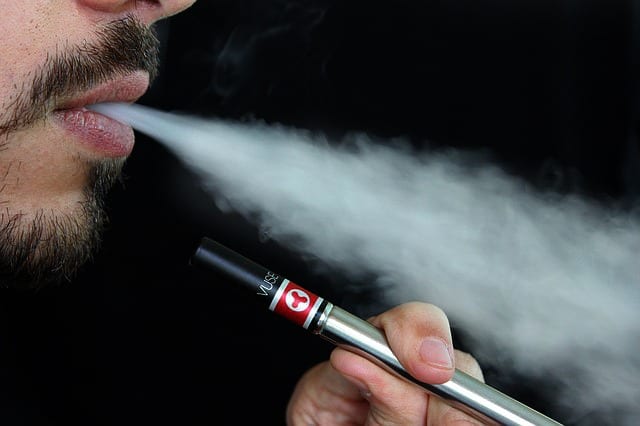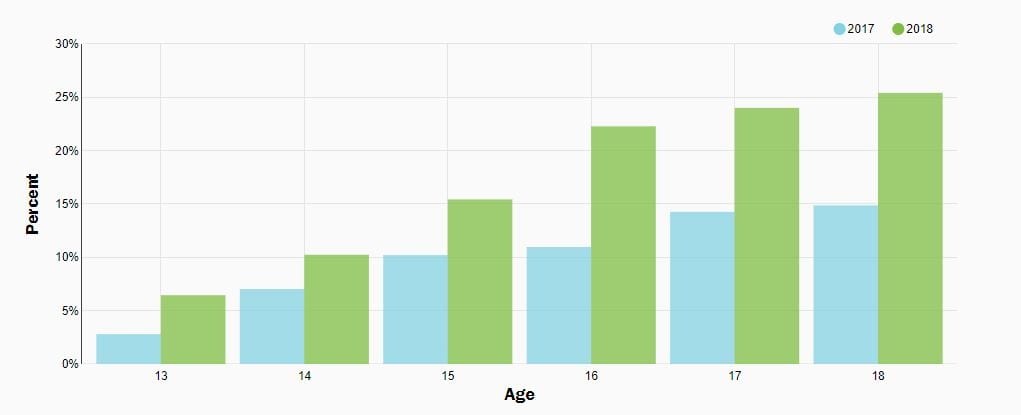
Updated Oct, 2023
Teen Vaping epidemic
Let’s look at the top article of the week before we get into the Teen vaping epidemic article.
Market crashes are associated with Panic and Fear
One should never panic for as we have repeatedly stated once you panic the outcome is always negative. The long-term chart of the Dow clearly illustrates why stock market crashes are nothing but buying opportunities in disguise. What the masses fail to understand is that when you feel good about investing in the markets, the markets are usually dangerously close to experiencing a massive correction. One has to go against the crowd if one expects to succeed in the markets. There is no such thing as teamwork when it comes to stock market investing; teamwork does not pay and will ensure that you are always rewarded with a solid kick in the head. The masses cannot win as there is not enough money to go around for everyone.
As we have repeatedly stated over and over again, panic is for fools; panic is for individuals who refuse to learn from history and who only love to lose. The same premise applies to Euphoria. What one needs to understand is that there are three phases in the markets; there is a time to buy, there is a time to sell (close your positions), and there is time to sit in cash (cash is a position) or if you are an aggressive trader, you can short the markets. Stock Market Predictions On When Markets Will Crash
Teen Vaping Surging
Vaping has indeed surged among teenagers in recent years, with media reports labeling it an epidemic. Despite this, my personal observations strongly suggest that this trend is far from slowing down. Vaping has firmly entrenched itself as a popular choice among the youth for various reasons, making it a pervasive and persistent issue.
The rise of teen vaping can be attributed to several factors. One significant driver is its affordability and convenience. Vaping devices and e-liquids are readily available at affordable prices, making it an accessible option for teens. The convenience factor can’t be overstated either; these devices are easy to conceal, discreet, and often come in appealing, pocket-sized designs that are enticing to young users.
Moreover, the perception that vaping is a safer alternative to traditional cigarettes plays a pivotal role in its popularity among teens. Numerous studies have indicated that vaping is less harmful than smoking, as it doesn’t involve burning tobacco and producing tar. This perception of reduced harm is a compelling factor that attracts teenagers, often luring them away from cigarettes.
The surge in teen vaping is also amplified by the enticing flavors offered by the vaping industry. From sweet and fruity to exotic and savory, the array of flavors available is vast. These flavors appeal to the younger demographic, making vaping more attractive compared to the limited flavors of traditional tobacco products.
The influence of peer pressure cannot be overlooked either. Adolescents are at an age where fitting in and being part of a social group is crucial. Vaping has become a part of youth culture, and this social acceptance fosters a sense of belonging, further fueling its growth.
The accessibility of vaping products in online markets and physical stores also contributes to its rise. With the click of a button or a quick visit to a local convenience store, teenagers can easily purchase e-cigarettes and e-liquids. The marketing strategies employed by some vaping companies have also been criticized for targeting younger audiences, using colorful packaging and social media influencers to create a buzz.
While the perception of vaping being safer than traditional cigarettes is not entirely unfounded, it doesn’t make it risk-free. Vaping still carries health risks, especially for developing adolescent brains, and its long-term effects are not fully understood.
In conclusion, the surge in teen vaping is a complex issue driven by multiple factors, including affordability, convenience, perceived safety, appealing flavors, social influence, and aggressive marketing. To address this challenge effectively, it’s essential to consider these factors comprehensively and develop strategies that target each aspect to curb the rising trend of teen vaping.
Alarming Rise in Youth E-Cigarette Use
The statistics are stark and undeniably concerning: a staggering 27.5% of the youth population regularly use e-cigarettes, a figure approximately 22 percentage points higher than the rate of high schoolers who smoke conventional cigarettes. This surge in e-cigarette usage among the youth raises significant alarms, not only due to its prevalence but also because of the myriad of health concerns associated with this trend.
One of the most prominent and distressing health concerns tied to e-cigarette usage is the association with severe lung and heart diseases. E-cigarettes, which were initially marketed as a safer alternative to traditional smoking, have been found to pose their own set of health risks. The inhalation of aerosols produced by these devices can lead to lung inflammation, compromising the respiratory system. Additionally, the nicotine and other chemicals found in e-cigarettes can increase the risk of cardiovascular issues, an unexpected consequence for many young users who believed vaping was harmless.
High nicotine content in some e-cigarettes is another detrimental aspect, particularly for adolescents. These devices can deliver nicotine in much higher concentrations than traditional cigarettes, significantly raising the risk of developing a nicotine addiction. This addiction, once established, can persist into adulthood, leading to a lifetime of health concerns and complications. Moreover, nicotine addiction during adolescence can hinder proper brain development, impacting cognitive functions and emotional well-being.
Beyond the nicotine issue, e-cigarettes expose youth users to a slew of harmful substances, including heavy metals. These toxins, when inhaled, can accumulate in the body over time and lead to a range of health problems. The long-term effects of such exposure are not yet fully understood, but they are a cause for worry.
Moreover, e-cigarettes are often seen as a gateway to smoking traditional cigarettes. While e-cigarettes were initially touted as a smoking cessation aid for adults, they have, paradoxically, lured many adolescents into nicotine addiction and, ultimately, to conventional cigarette use. This transition is deeply concerning as it exposes young individuals to a well-established source of severe health risks.
In conclusion, the surge in youth e-cigarette use, with a striking 27.5% of the youth population involved, is a grave concern. E-cigarettes, initially perceived as a safer alternative to traditional smoking, have now emerged as a major public health issue. They are linked to lung and heart diseases, nicotine addiction, exposure to harmful substances, and a concerning gateway to traditional cigarette smoking. Addressing this alarming trend requires comprehensive efforts in education, regulation, and awareness to protect the health and well-being of the younger generation.












Pathetic people and impressionable moronic kids with nothing better to do with their miserable lives!